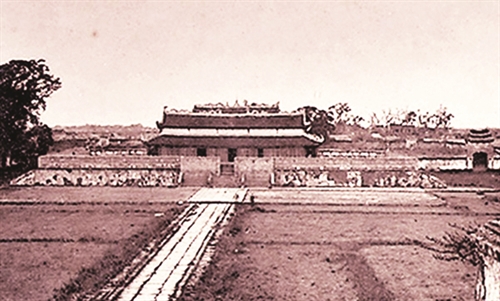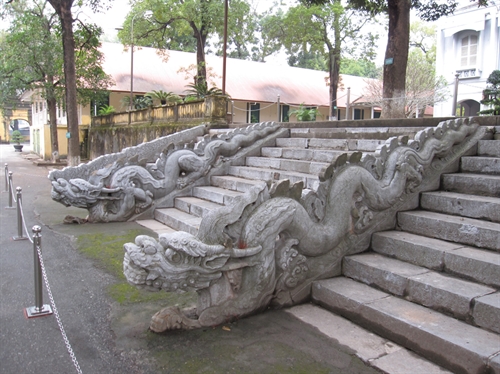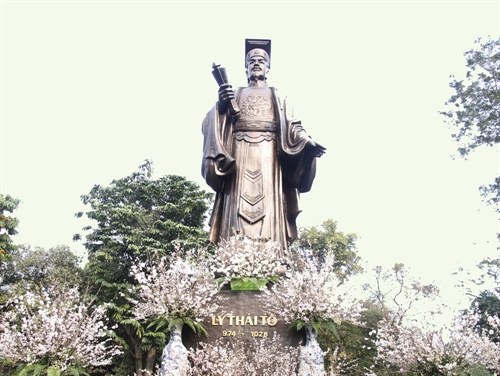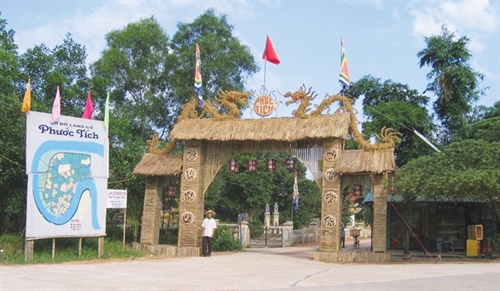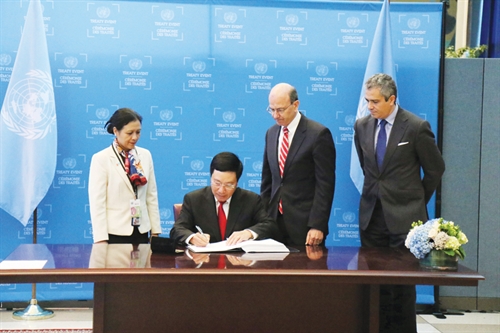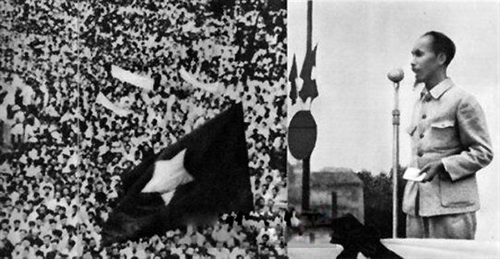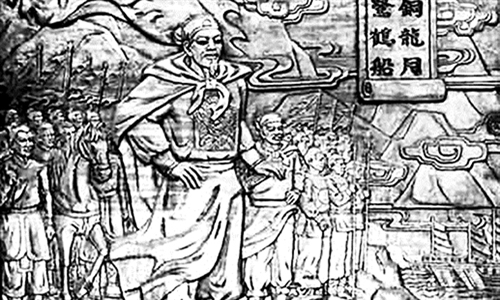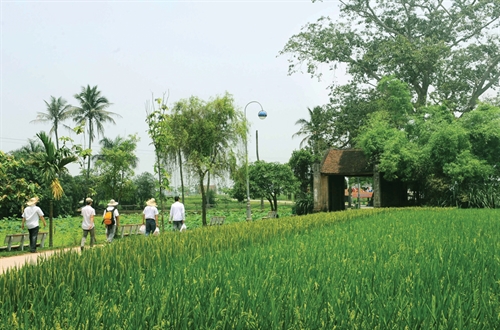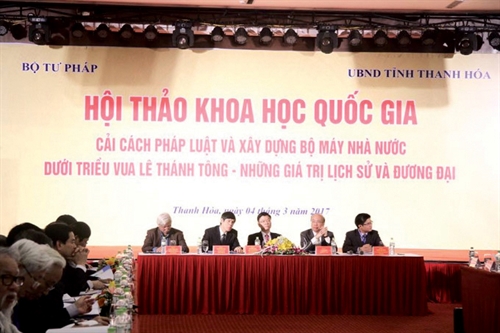Pham Thi Thu Hien
Hanoi Law University
The six ministries under the Nguyen dynasty and their supervision requirements
During more than 1,000 years of domination by northern feudalists, the Vietnamese feudal state was established after the state model of feudal China, from state institutions, ruling method, organizational system to mandarin titles. Following the reform initiated by King Le Thanh Tong (1442-1497), the state apparatus of feudal Vietnam was further developed with “luc bo” (six ministries) being key state agencies and the backbone of the central administration.
The functions and tasks of the six ministries were specifically determined by the Nguyen dynasty in 1833.
“Bo Lai” (Ministry of Honorific Personnel) was in charge of civil mandarin promotion, appointment, evaluation and commendation, formulating regulations on honorific title conferment and inheritance, drafting royal notices, orders…, and keeping records of civil mandarins.
“Bo Le” (Ministry of Rites) took charge of protocol affairs and rites, education, academic examinations, formal royal costumes, official seals, envoys and tributes, and managed various agencies such as “Thai thuong tu”, “Hong lo tu” and “Quang loc tu”.[1]
“Bo Ho” (Ministry of Revenue) was in charge of land policies, household registration, taxes and state funds.
“Bo Binh” (Ministry of Military Affairs) was in charge of transferring and appointing military mandarins, selecting and dispatching troops for battles, recruiting young men into the army, keeping records of military personnel; and managing “Thai bo tu” (an agency responsible for the royal boats, the king’s horses and the protection of wild life in the country), post offices and weapons depots.
“Bo Hinh” (Ministry of Justice) was in charge of judicial affairs, especially reviewing serious or complicated criminal cases.
“Bo Cong” (Ministry of Public Works) looked after construction, maintenance and repair of citadels and moats, bridges, culverts and roads, imposing bans related to mountains, forests and rivers[2].
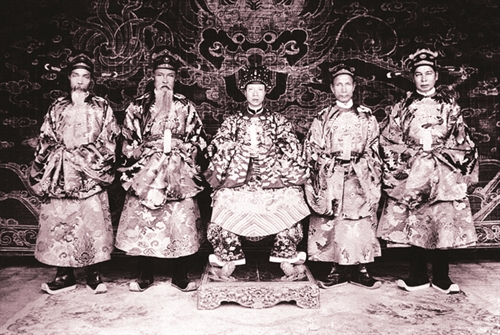 |
| Madarins of the Nguyen dynasty__Photo: Internet |
Apart from their specific functions, the six ministries were also vested with such general powers as advising the kings on political affairs; overseeing activities of the cabinet; and participating in adjudicative work within the scope of their duties.
Regarding the organizational structure of the six ministries, in 1802, King Gia Long, following the regulations from the Le dynasty, placed each ministry under the leadership of one mandarin called “Thuong thu” (minister) who was assisted by two “Tham Tri” (deputy ministers) and had an assisting office . Under the reign of King Minh Menh, the six ministries were restructured with each ministry led by a group of five mandarins, including “Thuong thu”, two “Tham Tri” and two “Thi lang”, and staffed with an average of 95 mandarins as against 108 during King Le Thanh Tong’s reign.
In the course of building and consolidating their monarchies, the Vietnamese emperors in general and the Nguyen kings in particular all wanted to concentrate power into their hands. Hence, in order to ensure the smooth operation of the state apparatus in accordance with the principle of “ton quan quyen” (respecting the king’s power), the Nguyen emperors applied various measures to restrict the power abuse or usurp and control corruption acts of mandarins.
Measures to oversee the six ministries
Supreme oversight by the kings
Following King Le Thanh Tong’s reform, the Vietnamese monarchies strongly developed. Strictly observing the principle of “ton quan quyen” on the organization and operation of the monarchical state, the Nguyen kings affirmed their power to be supreme, sacred and unique; all state bodies and mandarins only functioned to assist the kings. The six ministries were no exception. Functioning to enforce state power, they were placed under the supreme oversight of the kings. The Nguyen kings supervised the six ministries through various measures.
First, the Nguyen dynasty located the six ministries in Nhan Hau ward of the imperial city (which were previously placed in two wards of Liem Nang and Than Can under King Gia Long’s reign[3]). This helped settle affairs more promptly and facilitated the kings’ oversight.
Second, the kings performed supervision through promulgating documents, orders and instructions for ministerial officials. They set deadlines for settlement of affairs at the six ministries: “Important and urgent issues ordered to be immediately examined and settled must be reported within five days. If they cannot be handled in time, the reasons must be given for extension; otherwise, severe punishment will be imposed. Meanwhile, ordinary issues will be settled within one month.”[4] These regulations ensured that the kings could grasp activities of the ministries, oversee their work and urge them to settle matters on time. Or when finding many errors in adjudicative work, in 1823, King Minh Menh ordered Bo Hinh: “Mandarins have been assigned with clear responsibilities and must show greater caution in the coming time, ensuring fairness and justice in order to help me impose appropriate penalties. If being biased in favor of wrong-doers and committing mistakes as before, severe punishment will be imposed.”[5] Or in the criminal case involving Hoang Van Quyen and Tran Quang Tinh deputy ministers of “Bo Binh”, the king decreed: “Being subjects of the kings, loyalty and honesty must come first.”[6] Regarding official documents to be sent to foreign countries, which were related to the national honor and dignity, the king ordered that national documents drafted by “Bo Le” must be submitted to the cabinet and the royal court for approval before they could be sent.[7]
General oversight by “Do sat vien”
“Do sat vien” was established in 1832 under King Minh Menh’s reign with a view to creating a mechanism for supervising the state apparatus vertically from the central to local level and horizontally under the guiding principle of “using power to control power”.
“Do sat vien” was formed on the basis of merging the positions of “Do ngu su” and “Pho do ngu su” (chief supervisor and deputy chief supervisor) during King Gia Long’s time (1804) and “Cap su trung luc khoa” (officials of the six departments supervising the six ministries respectively) and “Giam sat ngu su” (supervisors) during King Minh Menh’s reign (1827). Unlike the period of Le kings, when “Luc khoa” and “Ngu su dai” were two independent bodies exercising supervisory rights, in order to enhance oversight of the six ministries, the Nguyen kings consolidated “Luc khoa” into “Do sat vien”.
“Do sat vien” was headed by four mandarins: “Ta do ngu su” and “Huu do ngu su” with competence similar to “Thuong thu”, and “Ta pho do ngu su” and “Huu pho do ngu su” with powers equal to those of “Tham tri” of the six ministries. Besides, there were six other officials and 16 supervisors in charge of supervising provinces. Mandarins working at “Do sat vien” were selected directly by the kings from among “Tham tri” of “Bo Hinh”, “Vien ngoai lang” (deputy heads of various offices) of the six ministries and senior provincial chiefs. The establishment of ranks and titles as well as the selection of mandarins for “Do sat vien” testified to the fact that the Nguyen dynasty attached great importance to the oversight of activities inside and outside the royal court.
“Do sat vien” oversaw acts of court mandarins, including royal relatives, in order to detect wrong-doings, injustice, dishonesty and power usurp for review and punishment. “Do sat vien” also supervised examinations to recruit talents for the country, ensuring their fairness. To perform its duties, this supervisory body was structured with oversight teams to discover corruption, harassment, injustice and law offenses committed by local mandarins. Officials and oversight teams of this body also had the right to supervise one another.
Under the regulations of the Nguyen dynasty, “Luc khoa” (six departments) under “Do sat vien”, including “Lai Khoa”, “Ho Khoa”, “Le Khoa”, “Binh Khoa”, “Hinh Khoa” and “Cong Khoa”, were assigned to inspect the six ministries, respectively[8].
Particularly, “Luc khoa” officials could report on wrong-doings and offenses committed by mandarins directly without the consent of “Do sat vien”[9].
“Do sat vien” was also empowered to hold appellate hearings to review judgments. All death sentences would be submitted to “Do sat vien” for inspection of their forms and contents after they were approved by “Bo Hinh”. In 1836, “Do sat vien” was assigned to inspect the cabinet and offices of the six ministries, during which it detected the loss of documents related to over 2,000 cases and proposed the prosecution of 100 persons[10]. Earlier in 1832, the King decreed “Do sat vien” to re-examine cases judged by Bo Hinh and report results to the King[11].
So, “Do sat vien” was actually the supreme supervisory body of the Nguyen dynasty. It created a strict supervisory system from the central to local level, contributing to enhancing the effect of the centralized monarchies, while ensuring the transparency and cleanness of the ruling apparatus in general and the six ministries in particular.
 |
| A painting illustrating a working session of the Nguyen dynasty’s “Bo Lai” (Ministry of Personnel)__Photo: Internet |
Oversight via the cabinet
In 1829, King Minh Menh set up a cabinet but limited its powers by providing the ranks of its leaders being lower than those of the six ministries in order to avoid concentrating too much power in this body. The Nguyen dynasty did not appoint a mandarin of highest rank to lead the cabinet for fear that he would have the powers like “Te tuong” (prime minister). Instead, four mandarins of the fourth rank were assigned to jointly manage the cabinet.
During the Nguyen dynasty, the cabinet was the central office of the emperor to administer political affairs of the kings and to receive information and consider and report on essential affairs to the kings. It also had an important duty of supervising the six ministries by making comment sheets and keeping records of activities of the ministries. These two methods of oversight helped ensure smooth coordination between the cabinet and six ministries in the course of performing official duties, as well as supervision and inspection of all activities of these bodies.
Oversight through the test regime
The Nguyen dynasty applied a test regime to incumbent mandarins, serving as a mechanism to oversee their performance and a basis for their promotion, demotion or dismissal on grounds of their virtues and talents.
“Kham dinh Dai Nam hoi dien su le” (Great Vietnam’s regulations on examinations) clearly recorded the test regime as follows: “A preliminary test of mandarins was organized once every three years and an overall test was organized once every nine years. At a preliminary test, civilian mandarins of third rank or higher in ministries and the cabinet, together with “tong doc” (provincial governors), “tuan phu” (provincial chiefs), “bo chinh”(provincial mandarins in charge of tax collection), “an sat”(provincial mandarins in charge of criminal cases) all had to make self-assessment reports, which would be classified into “uu”, “binh”, “thu” and “liet” grades. Mandarines receiving the “uu” or “binh” grade would be promoted or transferred; those graded “thu” would have their ranks unchanged while those with “liet” grade would be demoted or dismissed.[12]
Mandarins who had passed three preliminary tests would be eligible for taking an overall test, during which their performance and personal qualities would be reviewed and reported to “Bo Lai”. Depending on the testing results and ranks of mandarins, “Bo Lai” would decide on their promotion or demotion or report it to the king.
Oversight via “hac tau” (complaints and denunciations) of court officials
The Nguyen kings issued regulations allowing mandarins in the royal court and localities to complain or denounce each other. This mechanism proved to be highly effective in the oversight of activities of ministerial officials and was used by the kings as a measure to select and promote virtuous and talented persons to proper positions and dismiss lazy and corrupted mandarins. Together with the test regime, this mechanism helped purify the state apparatus in general and the six ministries in particular.
Oversight via inspection
Fully aware of the importance of inspection, King Minh Menh set a regime of inspecting the six ministries in order to examine and control their activities. In 1825, he realized that all funds and spending records were managed by “Bo Ho” while there were no regulations on their inspection. Hence, the king ordered that inspections would be carried out once every six years in the Year of the Cat and the Year of the Rooster[13]. In 1827, he found that “Bo Cong” was in charge of construction documents but was not subject to any inspection, hence, the king decided to inspect this ministry regularly in the Year of the Snake and the Year of the Pig[14]. Based on the opinions of courtiers, the king also decreed that inspectors of these two ministries would come from other ministries, “Do sat vien”, and “Dai ly tu” (Court of Judicial Review)[15].
So, the Nguyen dynasty established a strict regime of inspection and supervision in diverse forms of the six ministries as compared to the Le dynasty, thus creating the cross-examination among state bodies. The supervisory measures applied by the Nguyen dynasty yielded great impacts on the enforcement of the “respect for the king’s power” principle in the organization and operation of the state apparatus. On the other hand, through supervision, the Nguyen kings detected and handled wrong-doings and offenses committed by mandarins, then re-arranged personnel in the state apparatus in general and the ministries in particular.
The above supervisory mechanism established by the Nguyen dynasty has historic and practical values for the contemporary process of strengthening the state apparatus.-
